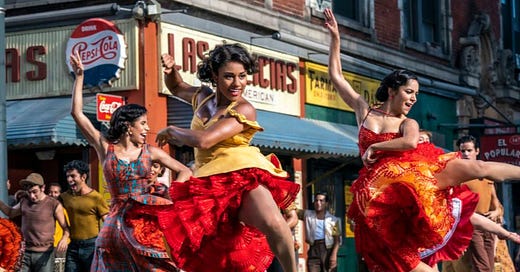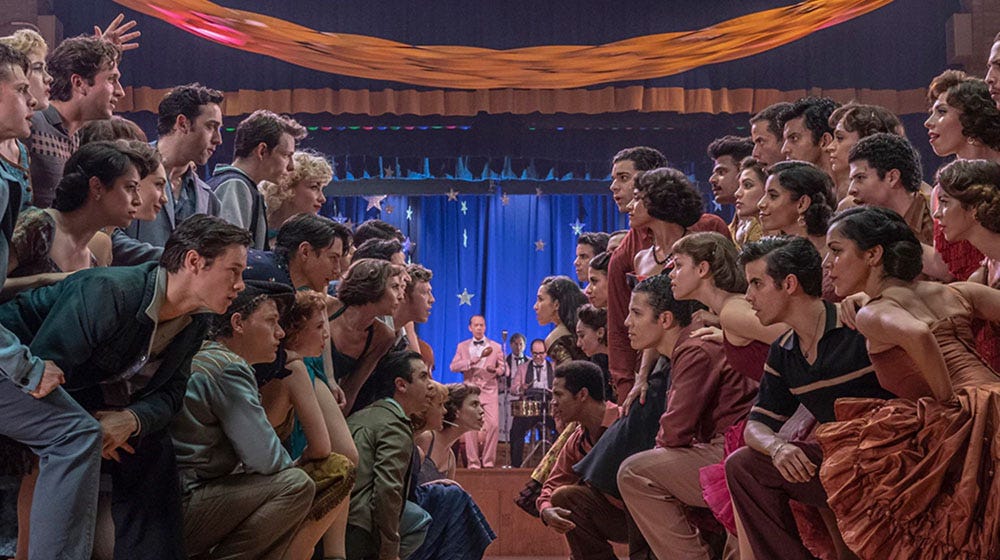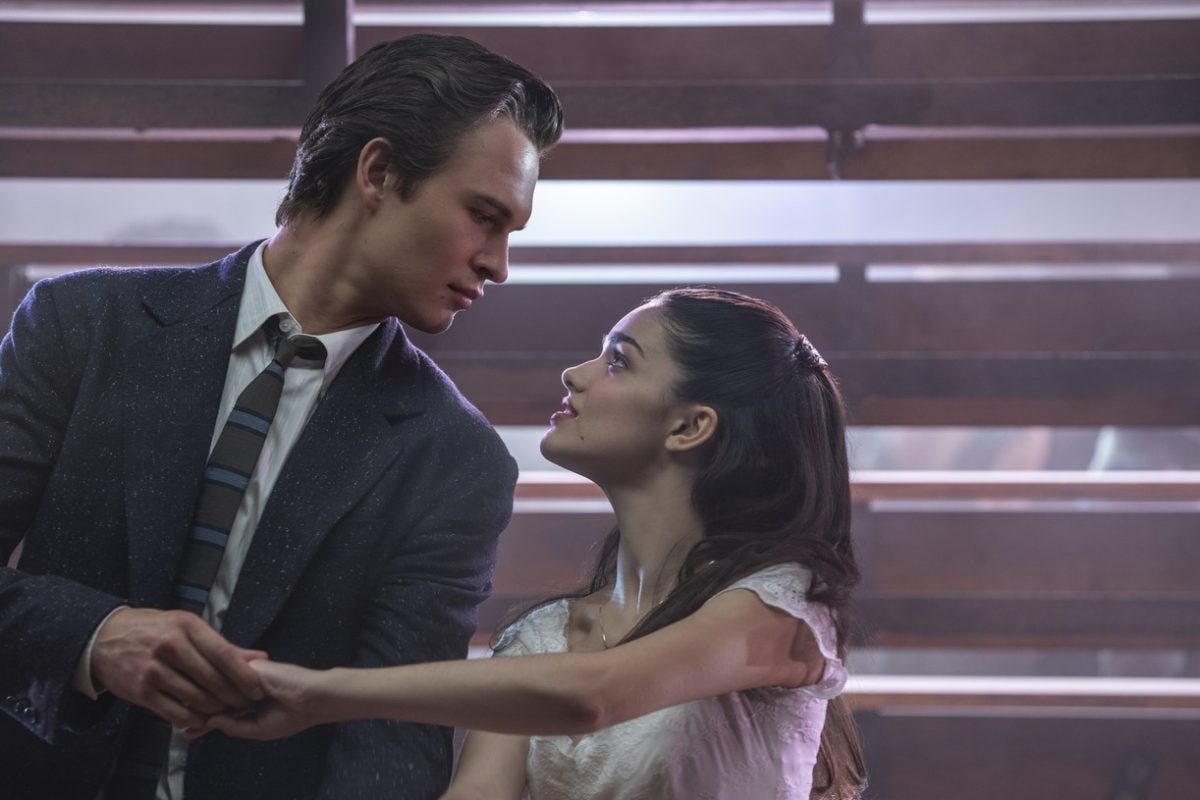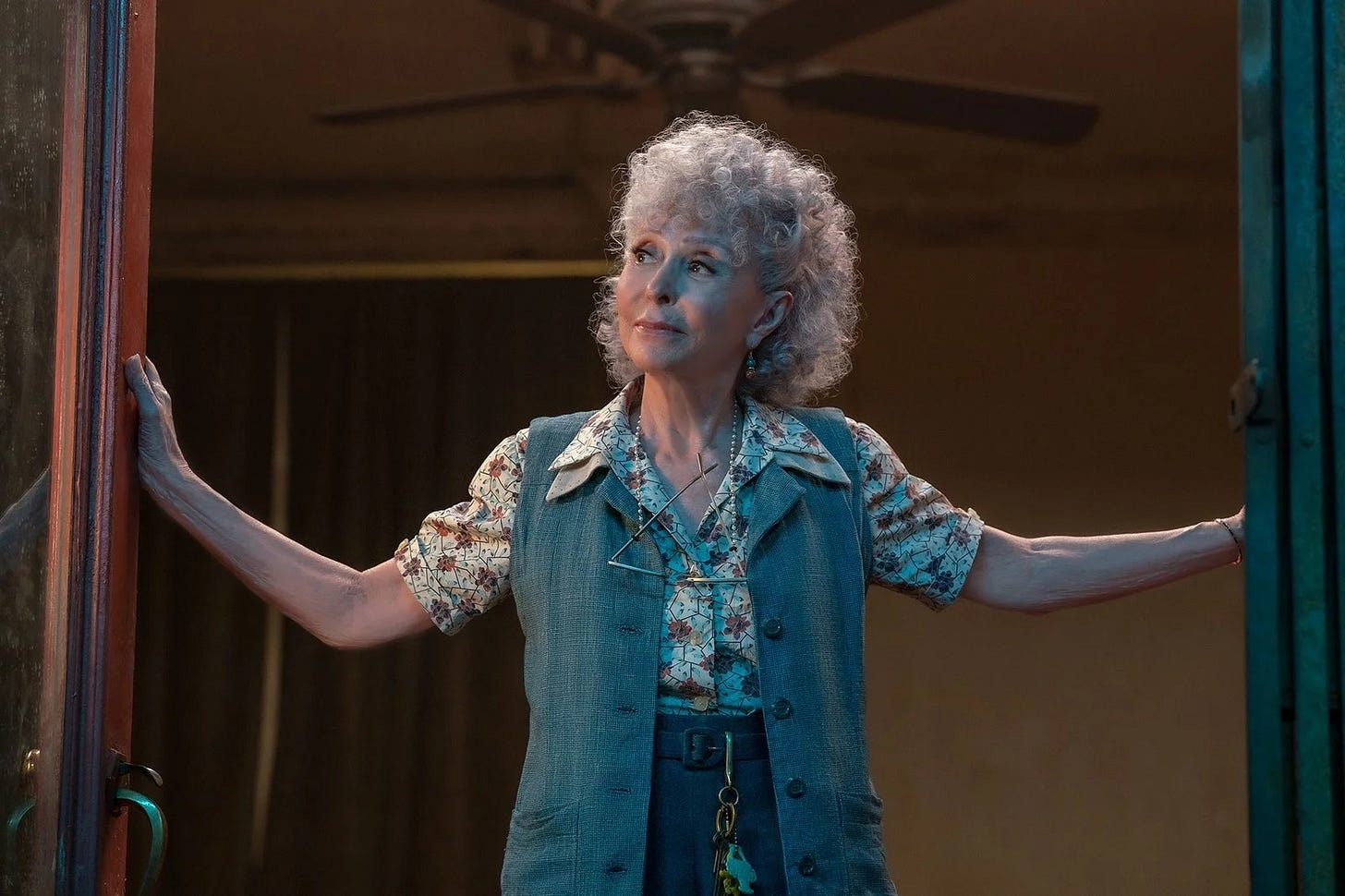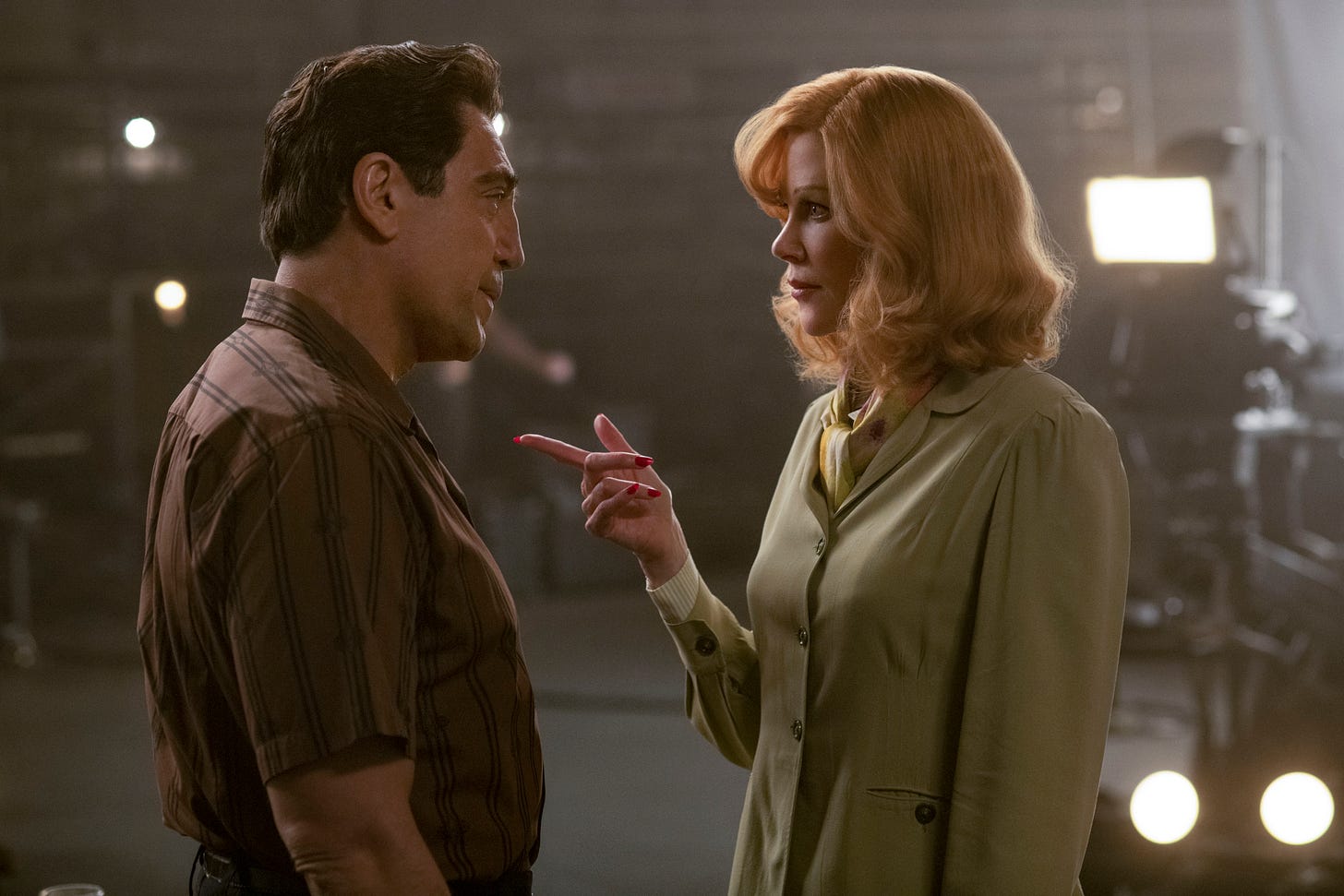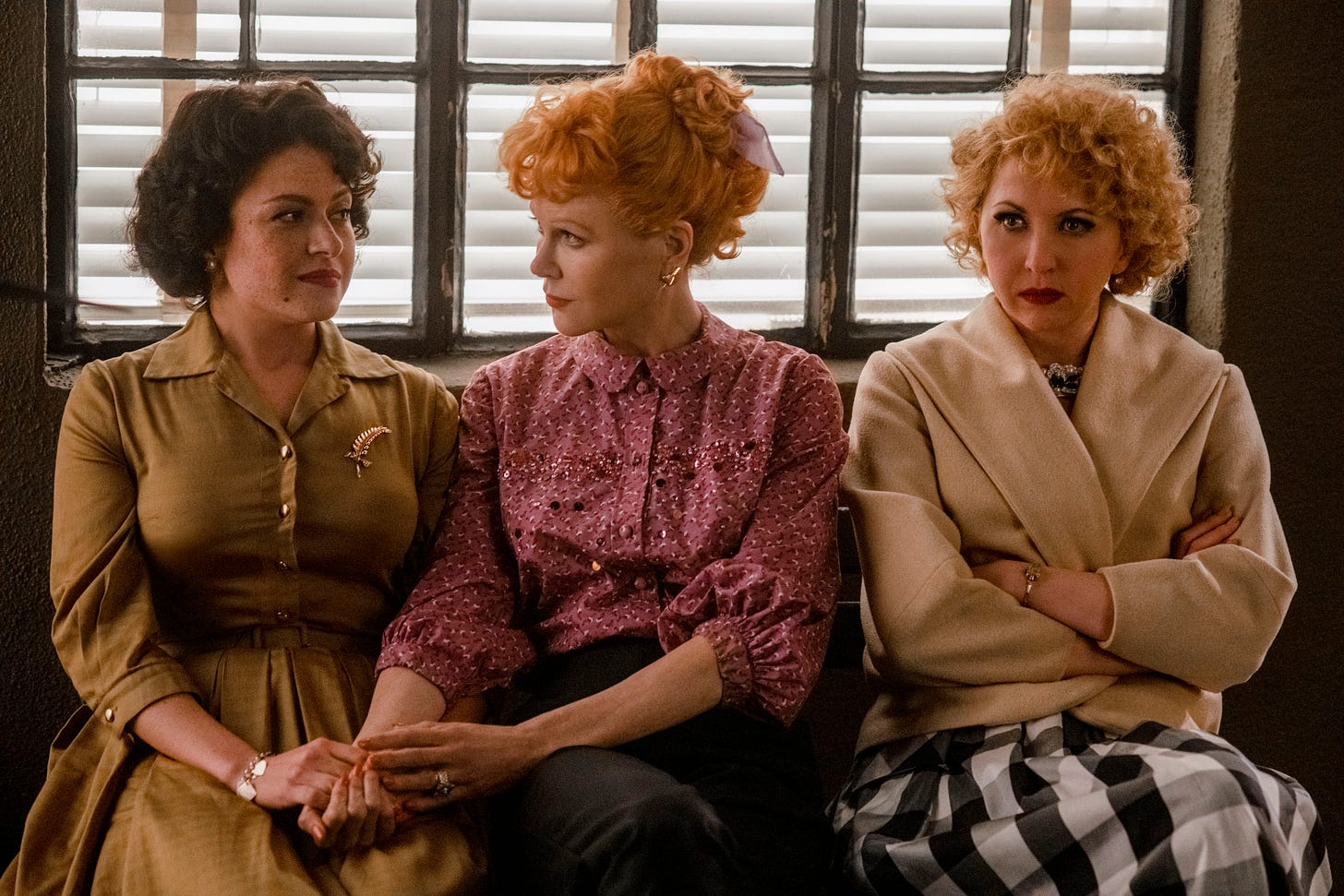Something's Coming. Something Good.
"West Side Story" is that rare beast, a remake that improves on a classic original. Plus, reviews for "Being the Ricardos" and "Don't Look Up". (Don't.)
The Nut Graf: Steven Spielberg’s “West Side Story” (in theaters, **** stars out of ****) reinvigorates a much-loved classic with style and substance. “Being the Ricardos” (in theaters now and on Amazon Prime Video Dec. 21, ** stars out of ****) balances a solid ensemble cast with a misguided star turn. “Don’t Look Up” (in theaters now and on Netflix Dec. 24, **1/2 stars out of ****) is a scattershot satire about the end of the world.
You can tell the new “West Side Story,” which opens in theaters today, is on to something special in the very first images. The original 1961 film, based on the 1957 Broadway musical, was filmed in a rush on the Upper West Side of Manhattan; urban renewal was coming, and tenements were being bulldozed to make way for an arts complex called Lincoln Center. What was offscreen in 1961 is center stage in the remake: The contested turf of the Jets and the Sharks is being razed in the name of progress and high culture, and the streets are filled with rubble. It’s a war zone, Dresden after the firebombing, and the struggle that plays out amidst the wreckage has the desperation of a community being forcibly disappeared.
I don’t want to take anything away from the first “West Side Story.” We grew up with it, and we keened with Natalie Wood as Maria, a Puerto Rican teenager grieving her lost love and singing in the voice of Marni Nixon. We were invested in the imposture and we wept. Yet anyone with eyes and ears and a heart has to acknowledge that Steven Spielberg has made the better movie. The new “West Side Story” is dramatically richer, better acted, more visually kinetic, and less ethnically bogus. At the same time, it retains the time period, the color scheme, and the choreographic DNA of the Robert Wise-directed original. This is still the “West Side Story” we know and love. It’s just been enhanced, and in all the right ways.
To start with: The script. The celebrated playwright Tony Kushner (“Angels in America”) has been brought on to refurbish the show’s book, which he does, brilliantly, not by changing things but by deepening them. Characters who were archetypal – or thinly drawn, if you want to be unkind – now have enough background to give them psychological depth. (And modernity. The lone Jets girl called Anybodys has always been portrayed as a tomboy: Now he’s trans.) We learn Tony is back from a yearlong stint in prison after beating a kid almost to death in a rumble; his reluctance to rejoin the gang, his rueful distance from Rif, and the hotheadedness that leads to tragedy all make sense now. Rif’s angry alienation from society is sharpened by his home being torn down; he’s taking it out on the Sharks when he should be taking it out on Robert Moses. Maria’s desire to break free of her brother’s smothering protectiveness is made clearer here, giving the character a spine that wasn’t there before. Even the simple relocation of Tony and Maria’s first meeting – they lock eyes on the gym’s dance floor, then drift behind the bleachers, coming together from opposite sides into an enclosed, privileged space – makes the scene more intimate, even erotic.
As for the casting, it took me a while to warm up to Ansel Elgort as Tony. He seems initially as clean-cut and borderline dull as Richard Beymer in the 1961 film, but we come to see the anger that has propelled Tony forward and the love that knocks him back. As Maria, Rachel Zegler is fantastic. She’s believably teenage (she was 18 during production two years ago; Elgort was 25). She’s Spanish-speaking from birth (her mother is Colombian). And she sings with a clear and powerful voice that’s her own. (“One Hand, One Heart” was recorded live on set rather than being pre-recorded, and Zegler’s singing is pure enough to break your heart.)
Ariana DeBose as Anita and David Alvarez as Bernardo are both excellent, and the emotions and physicality of their relationship has been beefed up in the script. (It matters that the Sharks speak a great deal of unsubtitled Spanish this time around.) Rif has always been the scene-stealer of this show, and Russ Tamblyn in the 1961 movie gave the character a hammy, enjoyable showbiz pizzazz. Mike Faist does something different – his Rif is charismatic but genuinely dangerous, a lean, racist switchblade of a kid who has run out of fucks to give. (It’s a Cagney of a performance.) Lastly, there is 89-year-old Rita Moreno as Valentina, owner of the grocery store where Tony works and his consigliere in life and love. (The character was written as Doc and has been played by a male actor in previous versions.) Moreno won a supporting actress Oscar as Anita in 1961; it’s not inconceivable that she might win another for this. Someone has made the wise choice to hand the late-second act ballad “Somewhere,” traditionally sung by Tony and Maria, to Moreno as a solo number, and suddenly the song’s sorrow, its urge to heal, extends not to two lovers but to our entire fractured world.
Spielberg directs at peak efficiency; “West Side Story” doesn’t bear a great filmmaker’s personal stamp so much as it represents a great filmmaker doing what he does best – using collaboration and unerringly right choices to serve and reinvigorate the material. You know you’re in good hands during that fluid opening sequence, as the Jets stride like hoodlum kings through their neighborhood and the random jeté and leap slowly coalesce into an elegant, athletic communal ballet. Choreographer Justin Peck keeps the essential vocabulary of Jerome Robbins’ iconic dance moves but builds on and recombines it in fresh ways. Most important, Spielberg and cinematographer Janusz Kaminski favor long shots that allow us to revel in the beauty of mass movement in set-pieces like “The Jet Song,” “America,” and “The Dance at the Gym” – none of that hyperactive “Chicago”-style cutting from disembodied foot to flailing arm. The camera really moves in this “West Side Story,” becoming as much a part of the dance as the dancers but never upstaging them.
It’s a measure of the film’s success that we all know how it’s going to end, and yet that ending still manages to crush one’s heart. The lights come up, we dry our tears, and we carry those songs back out into the world, maybe lifting up onto our toes occasionally as we go about our day. Lyricist Stephen Sondheim, not a man to give praise where praise was unwarranted, lived long enough to see this new “West Side Story” and pronounced it “great.” He wasn’t wrong.
“Being the Ricardos” also arrives in theaters this weekend — it hits Amazon Prime Video December 21 — and while I’m not sure that anyone actually asked for a movie about the backstage drama of “I Love Lucy,” here it is. And it is an odd duck indeed. It’s from writer-director Aaron Sorkin and, as expected, the dialogue and scene structure are so expertly and completely controlled that you’re torn between sighing in pleasure and wanting to scream. The action takes place during one week in 1952 when Ball has just been labelled a Communist by Walter Winchell and she and Desi Arnaz announce her pregnancy to the show’s producers. Both of these are potentially enough to give sponsor Philip Morris a corporate ulcer and pull the plug, and the point of the movie is to show a battle-scarred showbiz survivor and her whip-smart producer husband outthinking and outmaneuvering the suits while navigating bumps in their marriage.
The best thing about “Being the Ricardos” is its cast; the worst thing is its star. To my surprise, Javier Bardem makes a wonderful Desi Arnaz, quick-thinking, diplomatic, and very funny, and Nina Arianda brings her wit and authority to the part of Vivian Vance, who played Ethel Mertz on “I Love Lucy” and who here chafes under the passive-aggressive rivalry of her co-star and friend. J.K. Simmons plays William Frawley (a.k.a. Fred Mertz), Tony Hale (“Veep”) is “I Love Lucy” showrunner Jess Oppenheimer, and Alia Shawkat and Jake Lacy play the show’s writers. Deft hands all. And then we have Nicole Kidman as Ball.
There’s always perceptual static when a superstar plays a different superstar (think Tom Hanks as Fred Rogers or Anthony Hopkins as Alfred Hitchcock), but not once was I able to forget I was watching a strained approximation of an irreducible pop-culture figure. Kidman has Ball speaking in a nasal New Yawk skronk that doesn’t sound at all right and her way of imitating Lucy’s “who-me?” expression is to keep her eyes pinned wide open the entire movie. I’ve always thought it unsporting to discuss a performer’s cosmetic enhancements in the context of a review, but Kidman’s taut, lineless face here is a genuine distraction. Ball’s expressiveness was a major weapon in her comic arsenal; Kidman’s face never moves. (There’s also the small matter that Nicole Kidman is good at many things, but comedy isn’t one of them.) One of the points of the movie – one of the triumphs of Lucille Ball’s career – is that an actress who was kicked out of the movies for daring to turn 40 became a power on her own terms in the new medium of TV, and Kidman’s appearance in “Being the Ricardos” only makes the woman she’s playing seem weirdly unformed. The movie is a clash of the vanities.
“Don’t Look Up” hits theaters this weekend ahead of a December 24 Netflix debut, and I guess it’s the streaming giant’s intended entry in this year’s Oscar race. Pity, that. A blunderbuss satire with a tremendous cast, it stars Leonardo DiCaprio as a mild-mannered Michigan State astronomy professor who, with one of his graduate students (Jennifer Lawrence), discovers a comet headed toward Earth. Their calculations predict an extinction-level collision in six months, so the two head to Washington to warn the President (Meryl Streep) and take to a popular morning show (hosted by Tyler Perry and Cate Blanchett) to warn everyone else. The gag is that no one cares or dares to take them seriously, or they’re incapable of envisioning a catastrophe of said magnitude, or they’re too busy posting to Instagram. Then the comet becomes politicized as people divide angrily into camps of “Look Up!” acceptance and “Don’t Look Up!” denial. Ho ho ho.
Written and directed by Adam McKay from a story by columnist/political operative David Sirota, “Don’t Look Up” was obviously conceived as a metaphor for our response or lack thereof to climate change. It just as easily snaps into place for an age of pandemic, with DiCaprio’s character suffering the temptations of fame as he becomes a sort of astronomical version of Dr. Fauci. The talent is thick on the screen: Jonah Hill as the President’s chief of staff (and also her son), pop stars Ariana Grande and Kid Cudi as themselves (more or less), Timothée Chalamet as a skateboard punk, and a grand Mark Rylance as a Steve Jobs/Bill Gates-style tech guru – far and away the giddiest performance in the movie. That many characters and subplots dull the satiric knife, though, and while McKay has juggled well in the past – “The Big Short” (2015) and, to a lesser extent, “Vice” (2018) – too many of the balls get dropped this time. “Don’t Look Up” is frantic, fitfully funny, and a not a little exhausting, and behind all the japery is a righteous anger that could be put to better use elsewhere.
If you enjoyed this edition of Ty Burr’s Watch List, please feel free to share it with friends.
If you’re not a paying subscriber and would like to sign up for additional postings and to join the discussions, here’s how:
If you’re already a paying subscriber, I thank you for your generous support.

